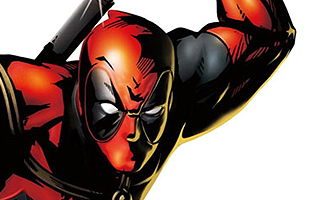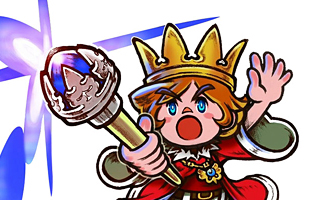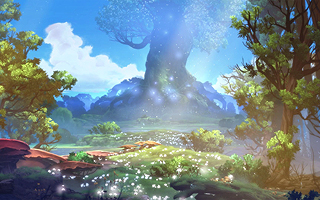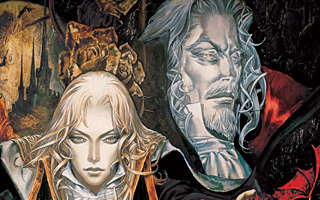WonderSwan
Top 10 Best Bandai WonderSwan Games of All Time!
The WonderSwan was the result of a partnership between Bandai and Gunpei Yokoi’s company, Koto Laboratory. (Yokoi had been instrumental to Nintendo’s success and helped create their Game & Watch line before following up with the Game Boy.) The WonderSwan was powered by a 16-bit CPU, but it followed the Game Boy’s lead in many ways. The low price point and long battery life helped attract consumers, and many of its games had built-in audiences. Bandai released numerous games based on licensed anime properties, and companies like Square, Namco, and Taito supported the system as third-party publishers. The WonderSwan was originally released with a monochromatic screen, but a color variation hit the market the following year. The WonderSwan was overwhelmed by competition from the Game Boy Color and Game Boy Advance, but the system itself had more promise than its underwhelming sales numbers suggest.
10
Klonoa of the Wind: Moonlight Museum
1999

The first Klonoa was one of the best platformers available for the PlayStation and helped pioneer the concept of “2.5D” games that used traditional 2D gameplay within 3D environments. For obvious reasons, Moonlight Museum adopted a fully 2D style, but the enemy-grabbing and double-jumping mechanics used in the original PlayStation game were retained. As the first handheld game in the series, Moonlight Museum helped set the stage for future portable releases and put a larger emphasis on environmental puzzles. Subsequent Klonoa games on the Game Boy Advance were basically built on the same foundation. Moonlight Museum would probably have benefited from a little more action, however. The game is pretty easy and there are no bosses to speak of, but it’s a lot of fun and has high replay value. Moonlight Museum is available exclusively in black-and-white, but the game makes good use of the WonderSwan’s hardware by allowing players to switch the perspective from horizontal to vertical for certain levels. Even though Moonlight Museum doesn’t quite live up to its own potential, it’s still the best (and most charming) platformer on the WonderSwan.
9
Beatmania for WonderSwan
1999

Konami’s Beatmania hit arcades in 1997 and contributed greatly to the popularity of music and rhythm games. In Beatmania, players assume the role of a DJ and are challenged to follow along with the onscreen instructions by manipulating five keys and a turntable controller. (Keep in mind that this was 12 years prior to the release of DJ Hero.) Players are judged on the timing of each input and will be penalized for playing the wrong keys or scratching at the wrong time. Beatmania for WonderSwan is actually based on Beatmania 3rdMix, and features surprisingly faithful renditions of the original arcade tunes. Even vocals are included, and the sound quality is vastly superior to the Game Boy port. The WonderSwan had ample buttons to replicate the arcade game and even came with a miniature turntable peripheral. The control scheme is somewhat awkward due to how the buttons on the WonderSwan are arranged and it’s easy to miss certain notes entirely, but it’s clear that a tremendous amount of effort went into making Beatmania for WonderSwan the best arcade port it could be. Rhyme Rider Kerorican is another interesting rhythm game that deserves a mention for its unique art style, but no game on this list serves as a better showcase for the WonderSwan’s sound capabilities.
8
Tane Wo Maku Tori
1999

The goal in Tane Wo Maku Tori (which roughly translates to “Seed-sowing Bird”) is to use movable tree limbs to guide falling tears onto the seeds below in order to help flowers grow. Players will be able to group tears together to form larger droplets, but they water itself can be intercepted by thirsty snails, spiders, and other animals. It’s a simple concept, but the game comes with a small children’s book to flesh out the story. Incidentally, the tears in question belong to a raven who is deeply saddened because his feathered friend has flown south for the winter. The raven spends the winter growing flowers with his tears while waiting to be reunited with his friend. In essence, Tane Wo Maku Tori is a story of sorrow and sowing. Like most good puzzle games, Tane Wo Maku Tori is easy to learn but difficult to master. Things can get pretty hectic after the first few stages. Anyone with an affinity for Nintendo’s classic Game & Watch series will feel right at home with the game. The WonderSwan is relatively obscure to begin with, so it’s probably safe to say that a quirky game like Tane Wo Maku Tori is unknown to most gamers. Major franchises from the likes of Square, Capcom, and Namco seemed to get the lion’s share of attention from the gaming press, so Tane Wo Maku Tori serves as a reminder of how deep the WonderSwan’s library really was. Tane Wo Maku Tori deserves to be a part of any WonderSwan collection, and the included storybook makes the game ideal for collectors.
7
One Piece: Grand Battle Swan Colosseum
2001

The WonderSwan’s library was full of licensed games based on anime and manga, and no property was more prevalent than One Piece. The series was in its infancy when the WonderSwan was on the market, but the handheld was still home to six different One Piece titles that included party games, RPGs, and fighting games like Grand Battle Swan Colosseum. The game’s starting roster includes six members of a sympathetic pirate troupe. Luffy is an aspiring pirate with rubber limbs, Zoro is a legendary swordsman, Sanji fights exclusively with his feet so as to not damage his hands, Nami is a feisty redhead with a nice rack, Usop is a cowering sniper, and Chopper is a raccoon dog. There are an additional seven enemy characters who can be unlocked, including Nico Robin and Fire Fist Ace. It’s certainly not the largest roster in a fighting game, but the characters are significantly different from one another. They all have unique attacks and also have their own idle animations that provide various benefits. Luffy will regain some life if he remains idle for long enough while Nami sees an increase in speed. There were a handful of noteworthy fighting games on the WonderSwan – including the only handheld version of Capcom’s Pocket Fighter and a super-deformed take on Guilty Gear. From a pure gameplay perspective, Guilty Gear Petit 2 is probably the best fighting game on the system, but I’m a huge One Piece fan and would rather spend my time with the Straw Hat Pirates.
6
Gunpey
1999

Every great handheld system needs a great puzzle game. The Game Boy had Tetris, the PSP had Lumines, the Gizmondo had Sticky Balls, and the WonderSwan had Gunpey. (Incidentally, the game was named in tribute to the designer of the game, Gunpei Yokoi, who was the main developer behind Nintendo’s Game Boy and Bandai’s WonderSwan.) The objective in Gunpey is arrange tiles on a 5×10 grid in an attempt to make a continuous line that extends across the entire length of the grid. Each tile contains a line fragment, but they won’t always align properly with the tiles beside them. In order to form a continuous line, it will be necessary to shift the tiles vertically. The game sounds more complex than it is, and anyone who can draw a line will be able to pick up the game with relative ease. Since the playing field is taller than it is wide, the game is played vertically to better optimize the WonderSwan’s screen. Gunpey features all the usual modes you would expect to see in a puzzle game. Endless mode challenges you to make as many lines as you can; Puzzle mode requires you to make a certain amount of lines in each stage while leaving no line fragments remaining; and VS mode allows two players to battle against each other. The game also contains a Story mode that allows players to compete against computer-controlled opponents. This mode plays a lot like the aforementioned Puzzle mode, but the computer will try to mess with the player through the use of shadowed panels and scrolling tiles. A western motif is used for the Story mode, and the characters have a lot of personality for a puzzle game. Gunpey EX was released in 2000 for the WonderSwan Color and introduced new color-based puzzles and other gameplay refinements. The story mode and western themes were removed, however, so I still prefer the original Gunpey.
5
Blue Wing Blitz
2001

Blue Wing Blitz is a turn-based tactical RPG from Square that focuses on aerial battles. Players will maneuver their aircraft around an isometric grid during their missions and are given various tasks like destroying their enemies or taking over enemy bases. When two aircraft come into contact with each other, they will engage in short menu-driven dogfights. The outcome of each battle is largely based on each aircraft’s stats, but there are a lot of variables to be mindful of. Individual parts of each craft can be damaged, and players will also have to keep an eye on fuel levels and ammunition supplies. The battles move quickly, but players have the option of changing altitude or taking evasive maneuvers to avoid combat. Between missions, players are given the opportunity to upgrade their aircraft and swap out equipment and weapons. The game feels similar to Front Mission – which makes sense considering that it was designed by the Front Mission team. The WonderSwan version of Front Mission felt like a cropped version of the Super Famicom original, but Blue Wing Blitz was designed specifically with the WonderSwan in mind and is the perfect fit for the system’s capabilities. The game never received an official English translation, wasn’t released on other platforms, and spawned exactly 0 sequels. Blue Wing Blitz is a game that truly belongs to the WonderSwan.
4
Dicing Knight Period
2004

The WonderWitch was an official development kit for the WonderSwan that allowed for the creation of hobbyist games. Although it was intended for amateur developers, a handful of WonderWitch games were commercially released. Dicing Knight Period was a winner of a WonderWitch development contest and was one of the last games officially released for the WonderSwan. The game is a rogue-like RPG that takes place in multi-layered dungeons. It moves along very quickly and is action-based, so fans of Zelda or Mana franchises will feel right at home with it. The graphics are fairly repetitive and all of the rooms look the same, but the environments are destructible and the enemies have various attack patterns and behaviors. The game has a lot of cool pick-ups too, so you feel like you’re constantly being rewarded. I really appreciate how Dicing Knight Period makes use of all of the WonderSwan’s buttons. The A and B buttons allow the player to use their sword and shield weapons at all times, the primary directional buttons are used to control movement, and the secondary set of directional buttons can be assigned to various inventory items. The fact that you don’t have to constantly jump into menu screens to select items contributes greatly to the pacing of the game.
3
Mr. Driller
2001

Mr. Driller is essentially a puzzle game disguised as an action game, and it draws a lot of inspiration from classics like Boulder Dash and Namco’s own Dig Dug series. (Mr. Driller was actually intended to be the third game in the Dig Dug series, but Namco decided to market it as a spinoff instead.) The objective in Mr. Driller is to drill down through a series of colored blocks. This is easier said than done, since making wrong moves can cause other blocks to collapse down onto you. Players also have to be mindful of their air supply which is constantly depleting. Capsules of air along the way will keep you alive, but senselessly drilling down through the onslaught of colored bricks is a losing strategy. Since certain blocks require more power to drill through, it will be necessary to plan your moves carefully while still acting quickly. The WonderSwan version of Mr. Driller is basically a direct port of the original 1999 arcade game, but it was a great fit for the system. The WonderSwan’s wider screen made the game feel less claustrophobic than the Game Boy Color port that was released around the same time.
2
Final Fantasy
2000

Final Fantasy was initially conceived as Square’s swan song, but it helped the company soar to new heights when it was released on the Famicom in 1987. The 8-bit graphics of the original were given a 16-bit update in the WonderSwan port, but it was basically the same game with a few interface refinements. Companies like Capcom and Namco had pledged their support to the WonderSwan early on, but it was Final Fantasy that helped define the system. The most notable aspect about Final Fantasy is that it allows players to create a party of their own design. Upon starting a new game, players assign occupations to each of the four protagonists. These occupations each have their own attributes and abilities associated with them, and they also determine which spells the characters can learn and which weapons they can use. It’s beneficial to create a well-rounded party, but players can create a team comprised exclusively of fighters or black mages if they are so inclined. There are six character classes to choose from, and experimenting with different combinations adds a lot of replay value to the game. Final Fantasy was a product of the 1980s, so it can be difficult to jump into. The game is as hard as nails from the very beginning, and players aren’t given a lot of direction. The extreme difficulty will force players to stock up on supplies and fight countless battles in order to gain experience points. Anyone who is willing to invest a little time into the game will be able to see why it is so beloved. With a huge map to explore and countless items to collect, Final Fantasy has tons of content. The story is entertaining, the music is fantastic, and the replay value is off the charts for an RPG.
1
Final Fantasy IV
2002

It was neither the first nor the best in the series, but Final Fantasy IV was a huge step forward for the Final Fantasy franchise and helped advance the entire genre. The game’s most significant innovation was the introduction of the “Active Time Battle” system, which added oceanic depth to the traditional turn-based battles that the genre was known for. (The game also introduced North American gamers to chocobos and monster summons when it was released on the SNES as Final Fantasy II.) The visuals were significantly better than its Famicom predecessors, and the score was breathtakingly beautiful. One of its tracks has even been taught in Japanese schools as part of the music curriculum. The quest is fairly linear, but this is easy to overlook because you’ll actually care about the game’s characters. The scenarios themselves are a lot of fun too. During the adventure, you’ll fly around in airships, travel underground, and even take a trip to the moon! The game never stops giving players reasons to sympathize with the characters, and Cecil’s inner struggle helps set the tone for an epic quest. The graphics in the WonderSwan version of Final Fantasy IV were a little more detailed than the SNES release, but the soundtrack has a distinct a 8-bit feel to it. There’s not much sense in pining over minor differences. Final Fantasy IV is one of the most engaging RPGs of all time, and the WonderSwan port marked the first time the game could be played on a handheld system.





Do you agree with this list? Let us know what you think by leaving a comment below. Your opinion matters!